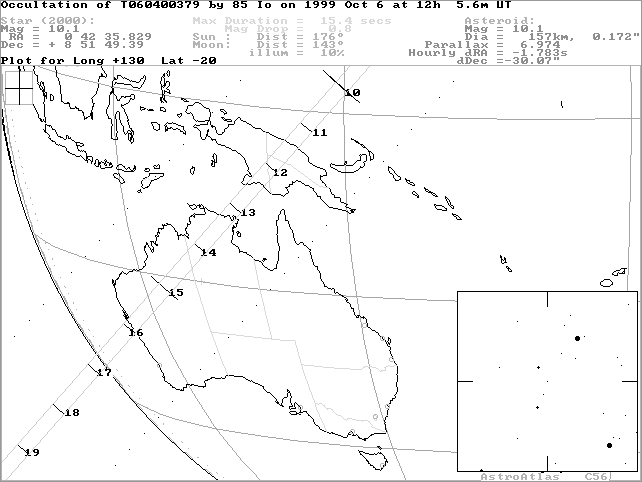ASTROMETRIC UPDATE:
OCCULTATION BY (85) IO - 1999 OCTOBER 6
CHECK THIS PAGE REGULARLY FOR FURTHER UPDATES AND CHANGES TO THE TRACK.
YOU MUST RELOAD THIS PAGE USING YOUR BROWSER'S
RELOAD/REFRESH BUTTON TO OBTAIN UPDATES!
[Prediction using OCCULT software]
The predicted path lies across northwestern Australia.
UPDATE: 5 October 1999
This prediction update has been computed by Graham Blow based on astrometry from Alex Liu in Western Australia. The ACT position of the target star has been used.
Summary:
Note that the astrometric reduction has been carried out against GSC star positions, which may lead to a less accurate overall result.
The update suggests a shift of about 3 track widths eastwards with the occultation time about one minute later than that predicted by OCCULT.
The path remains over northwestern Australia.
THE EVENT AT ONE GLIMPSE:
- Date and approx. UT time of event: October 6, 1999 @ 12:15 UT
- Magnitude of target star: 10.3
- Magnitude drop [mag]: 0.7
- Estimated maximum duration [s]: 17.5
- Path description: See above.
The Occultation Path:
- Approximate width [km]: 178
Data for the target star:
- Name: TYC 0604 00379
- Constellation: Pisces
- J2000 position [h,m,s; o,',"]: 00h 42m 35.829s; +08o 51' 49.39"
- Position source: ACT
- V mag [mag]: 10.3
Data for the minor planet:
- Number, name: (85) Io
- Approx. diameter [km]: 178
- Source of used astrometry: Liu
- Number of used observations: 6
- Number of rejected observations: -
- Time covered by the observations: 1998 10 04
Data for the event:
- UT date and time of least geocentric approach: 12:05:36 UT
- Approx. V mag of minor planet at event [mag]: 10.1
- Geocentric parallax of minor planet ["]: 6.97
- Magnitude drop [mag]: 0.7
- Estimated maximum duration [s]: 17.5
- Apparent motion of minor planet ["/h]: 40.03
- Angular distance to moon, phase of moon [deg,%]: 144, 9%
- Update computed by: Blow

IMPORTANT NOTE!
Astrometric updates such as these should not be taken as definitive, but rather only as an indication of where the true track may lie relative to the original predicted track. Observers must bear in mind that later astrometry, in which the target star is measured in the same field as the asteroid, may still reveal substantial changes to the predicted track and time of the event. For this reason it is most important that observers far from the predicted track still monitor the event.
Use these links for further information:
[Planetary Occultations]
[Using the Predictions]
[Observing Details]
[Timing Details]
[Reporting Details]
[Report Form]
[Asteroid Occultation Results]
This page may have been updated since 5 October 1999.
Hit your browser's RELOAD button to get the latest version.
[Site Map]
[What's an Occultation?]
[Total Occultations]
[Grazing Occultations]
[Planetary Occultations]
[Jovian Satellite Eclipses]
[Timing Occultations]
[Reporting Observations]
[Coming Events]
[Software]
[About Us]
[Publications]
[Membership]
[Links]
[Top of Page][Return to Home Page]
